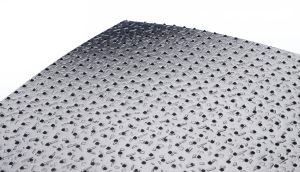Geomembranes, predominately linear low-density polyethylene (LLDPE), have been used for landfill caps for decades. Waste Management World has noted how,” Generally they have performed extremely well but, not unexpectedly, there have been a few exceptions that have guided us in developing even better systems.” Currently, there are four commonly used options for landfill caps, each with their plusses and minuses, especially with respect to stability.
Geomembrane and soil composites. In use around the world, geomembrane and soil composites are technically feasible in all climates. They do require soil depths suitable to the selected vegetative community used to hold the topsoil system together; and their stability is based on veneer interface strengths.
Synthetic turf cover. Here, synthetic turf replaces the soil protection and vegetative cover layers and protects the underlying membrane from UV degradation. Stability is less of a concern and cost savings can be significant given the substantial decrease in post-closure care and soil cover savings.
Exposed geomembrane cover. This is the least expensive option that employs geosynthetics. Other than wind uplift, stability is a lesser concern. However, because these covers are subject to ultraviolet degradation and wind uplift, their use has been limited to temporary covers.
Monosoil, water-based or evapotranspirative covers. Technically feasible for drier climates (those with 19 inches or less of annual precipitation), these require an appropriate fine-grain soil and long-rooted vegetative community. Their stability is based on the soil’s internal shear strength and erosion resistance.
Why is stability design so important? In March 1988, at the Kettleman Hills hazardous waste facility in California, a slope failure in the containment cell led to displaced waste and years of litigation. The investigation showed an elaborate lining system in which all of the components were smooth, as textured geomembranes were not yet offered in the marketplace.
Numerous recent slope failures on closure projects in various parts of the country have been blamed in part on faulty design and materials selection.
“In order to stop liners and caps from sliding down slopes, they are often textured or structured to enhance friction with the underlying soil or non-woven geotextile on GCLs and geocomposites,” reads a recent Waste Management World article. “Texturing is a random ‘rough sea’ profile, while structured profiles are engineered profiles designed to interact optimally with different mating surfaces.” Texturing is the process utilized during the blown film manufacturing process while structured profiles are created using the advanced flat die extrusion calendaring manufacturing process.

Agru America’s MicroSpike Liner is the material of choice in containment applications where slope stability is critical. Consistent surface structuring gives the textured geomembrane reproducible friction angle values with the highest surface friction values in the industry. Manufactured using a patented flat die extrusion calendaring production process, MicroSpike Liner is the only textured liner with a consistent core thickness, resulting in significantly greater puncture,tear, and elongation values when compared to standard blown film products.
The material provides excellent friction characteristics with sand, clay, geotextile and geocomposite. Its exceptional shear resistance between soil and geotextile components allows flexibility and stability during protective cover material placement. The textured asperity height is not only consistent but higher than competitive textured products.